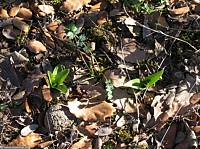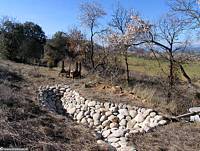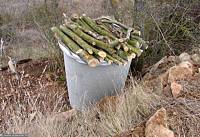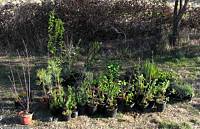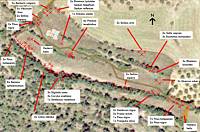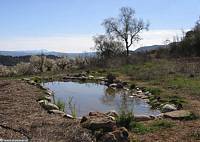|
|
Nature
Switched On
|
|
||||||||||||||||||||||||||||||||||||||||||||||||||
|
introduction |
2008 March 15 & 16, Saturday & Sunday
|
|
||||||||||||||||||||||||||||||||||||||||||||||||||
|
Last weekend I finished the second pond and the connection with the irrigation water deposit. Instead of using a salvaged concrete pipe as a connection (on the photo on the right) I decided to use a PE tube which goes partly underground and partly hidden by roof tiles and connects to a water inlet at the bottom of the deposit. An outlet connects with another tube that runs through the concrete pipe and ends with a tap for easy bucket filling.
The deposit had to be covered to protect against animals
(mosquitoes) and falling leaves. I used some plastic on which I put
some chopped Plane sticks. Not really the most aesthetic or
practical solution but for the moment it will do.
|
||||||||||||||||||||||||||||||||||||||||||||||||||||
|
The zone bordering the second pond is covered
with mulch to stimulate regrowth. |
||||||||||||||||||||||||||||||||||||||||||||||||||||
|
Here the connection goes underground. |
The PE tube on the right is
covered with roof tiles and the tube on the left goes through a
concrete pipe and ends with a tap. Photograph taken on 10 March 12:36 |
|||||||||||||||||||||||||||||||||||||||||||||||||||
|
With two ponds and a water deposit we have the possibility to store more than 10,000 litre of rainwater, so now we feel a little more confident to buy and plant some more species. This weekend we decided to pay a visit to Cultidelta, a garden centre at the delta of the river Ebro. It is one of the few companies dedicated to the growing of autochthonous species in Spain and after eight years they already have an impressive catalogue. We bought the following species, most of them adapted to dry, calcareous soil and native of the region:
|
||||||||||||||||||||||||||||||||||||||||||||||||||||
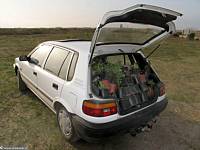
We were a little bit worried about the capacity of
our car to transport more than 100 flowerpots but for Enric, the
helpful owner, it was a
routine job and loaded the pots in horizontal layers, filling up the
whole backspace of the car. The roots were sufficiently developed to
fix the soil and all plants |
At the delta of the river Ebro,
with the car filled up. Saturday 15 March 17:38 |
|||||||||||||||||||||||||||||||||||||||||||||||||||
|
After the trip. Sunday 9:15 |
||||||||||||||||||||||||||||||||||||||||||||||||||||
|
The next day we planted them, taking care not to plant in places
which are too exposed to sun, wind or trampling. This meant that
many species were planted near hedgerows or the oak wood. Especially
the shrubs will help to establish a transition zone between the
grassland and the w
In the pond we planted about 40 Sword flag (Iris
pseudacorus). A little bit overdone but this
|
||||||||||||||||||||||||||||||||||||||||||||||||||||
|
Planting scheme. March 2008 |
||||||||||||||||||||||||||||||||||||||||||||||||||||
|
Iris pseudacorus planted in the
first pond. |
||||||||||||||||||||||||||||||||||||||||||||||||||||
|
introduction
|
|
